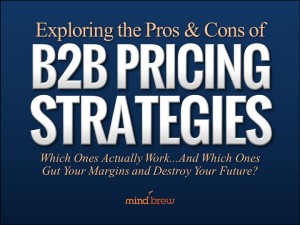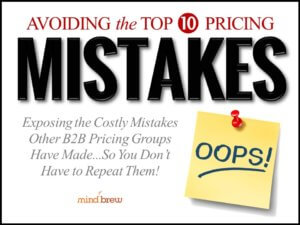We regularly get questions from subscribers who are interested in learning the “right way” to create a pricing strategy.
The problem, of course, is that there several different viable options for pricing strategies. The right one for your company is going to depend on a whole host of factors that are unique to your market and your company.
But while there might not be universal pricing strategy that’s “right”, some approaches are definitely wrong. If you can avoid those, you’ll be well on your way to creating effective pricing for your company. Here are four of the worst:
1. Competitive matching—Price-matching can work as a strategy only when two very specific conditions are met. One, the products being compared are identical. And two, you know what your competitors are charging.
In most B2B markets, neither of these conditions exist.
It’s tempting to let your competitors do your pricing work for you and just copy their prices. It will be far more valuable in the long run to figure out what differentiates your product from other options and set prices based on the value that represents to your customers.
2. Loss-leader pricing—We’ve all experienced this at the grocery store, right? A store will put hamburger on sale for about a quarter of what it usually costs, hoping to draw in a bunch of customers who will do all of their food shopping while they are there. This sometimes works in the grocery store (although some retailers who analyze the data have found that it doesn’t work as well as they though it did) because customers have limited time for grocery shopping. Plus, going to a lot of different stores is a pain.
But B2B buyers often have systems specifically set up to help them source products from lots of different vendors. They don’t mind buying from twenty-seven different stores if that gets them the best value for their money. If you offer a loss-leader, they probably won’t buy anything else from you. And that will leave you with a loss.
3. Penetration pricing—Consumers are sometimes willing to try a brand new category of product if the price is right. But businesses aren’t going to buy something unless they really need it. And if you’ve done the hard work to convince businesses that they need something, you don’t need to offer them a low price to get them to try it.
In the B2B space, penetration pricing almost always leaves money on the table. It may help you pull in some price buyers who might otherwise have chosen a different option, but it leaves you with much smaller margins than necessary.
4. “Brand”-driven preferences—If you are completely honest with yourself, your preference for a particular brand of soda or beer is probably related to the emotional attachment you feel for that product. Maybe it resulted from their advertising or maybe it came from a particular experience you had as a child. In any event, no one is creating spreadsheets to compare the relative value of Coke vs. Pepsi or Coors vs. Budweiser while they are in the store deciding what to buy.
However, in the B2B world, people often do create those spreadsheets. Of course, buyers still have emotions that can play a role in the eventual decision, but most businesses have processes in place that limit the effect those emotions can have. Whenever someone in your organization recommends charging a higher price based on your brand’s intangibles, you should be highly suspicious.
So if that’s what not to do, what should you be doing instead? You can get a closer look at the relative merits of different pricing strategies in the webinar The Pros & Cons of B2B Pricing Strategies. It takes a closer look at some of the options we discussed here as well as delving into some of our most highly recommended pricing strategies.














